
For centuries, the question of whether wild animals feel love like humans has captivated us. Indeed, we see their protectiveness. Furthermore, we observe their loyal pairings. However, groundbreaking new research offers compelling evidence. Consequently, it suggests that wild animals experience love. They form deep bonds. Their capacity for affection is profound. Moreover, it is more widespread than previously imagined. Therefore, this new understanding changes our view. It alters how we see the emotional lives of creatures in the wild.
The Emerging Science of Love in Wild Animals
The idea that wild animals feel love is, in fact, gaining traction. The scientific community is, in particular, paying attention. Researchers use sophisticated methods. For example, they explore the emotional depths of various species. This happens in their natural habitats.
Investigating How Wild Animals Experience Love
Specifically, studies analyze hormonal changes. Oxytocin release during social interactions is one example. Thus, this provides physiological evidence for bonding in wild animals. Moreover, observing social behaviors is also key. For instance, cooperative hunting in wolves shows loyalty. Consequently, this supports the idea of love among wild animals. It is, without a doubt, a powerful force.

Real-World Examples of Love Among Wild Animals
The natural world offers many examples. These strongly suggest wild animals feel love.
- Lifelong Bonds of Love: For example, many bird species form monogamous pairs. This demonstrates enduring love in wild animal relationships. They share care. Also, they have elaborate courtship.
- The Profound Love of a Mother: In particular, maternal care is evident in bears and lions. This showcases intense animal maternal love. It goes beyond instinct. Instead, it includes nurturing and comfort.
- Social Love Through Grooming: Similarly, primates engage in social grooming. This reinforces love and bonding in wild animal communities. It happens through pleasurable physical contact.
- Love and Cooperation in Groups: Furthermore, elephant herds show strong familial ties. They also display apparent grief. Therefore, this indicates deep emotional attachments. There is, indeed, love within wild animal families.
Why Understanding Animal Emotions Matters
Recognizing that wild animals feel love has profound implications. Consequently, it affects conservation efforts. Moreover, it influences our ethical treatment of wildlife. Understanding their social needs is crucial. Similarly, understanding their emotional vulnerabilities is also key. This can lead to more humane strategies. Furthermore, it can also lead to more effective conservation. Knowing about family bonds in certain species is important. Thus, this can influence decisions about habitat preservation. It also affects the impact of human activities.

Actionable Takeaways:
- Support Ethical Conservation: To begin with, choose organizations that prioritize animal well-being. They should also respect natural social structures.
- Educate Yourself and Others: Furthermore, learn about the emotional lives of wild animals. Share this knowledge. As a result, foster greater empathy and respect.
- Make Informed Choices: Finally, consider your consumption habits. Think about your lifestyle’s impact on wildlife habitats. Remember the animals that live there.
The Future of Research on Animal Emotions
The field of animal cognition is evolving. Likewise, so is the study of emotion. Technology is advancing. Consequently, research methods are becoming more refined. We will likely uncover deeper insights. This will be about the emotional lives of wild animals. This growing understanding will, therefore, enrich our appreciation. It will be for the natural world. It will also challenge us. We must reconsider our relationship with its inhabitants. The emerging consensus is clear. The capacity to love is not unique to humans. Instead, it is a thread. It weaves through all life on Earth.
(Image Placeholder 4: A visually striking image of a diverse group of wild animals in their natural environment, symbolizing the interconnectedness of life.)

